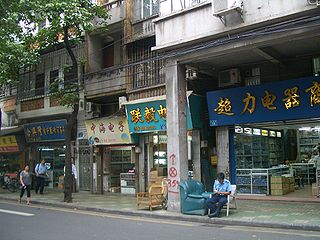The relationship substance framework is a conceptual model for understanding business-to-business (B2B) relationships, developed and championed by the Industrial Marketing and Purchasing Group (IMP Group) and adopted particularly in Scandinavian studies of industrial practice. The IMP Group have proposed that all business relationships are made up of three layers - actor bonds, resource ties and activity links.
A conceptual model is a representation of a system, made of the composition of concepts which are used to help people know, understand, or simulate a subject the model represents. It is also a set of concepts. Some models are physical objects; for example, a toy model which may be assembled, and may be made to work like the object it represents.

Business-to-business is a situation where one business makes a commercial transaction with another. This typically occurs when:
The Industrial Marketing and Purchasing Group or International Marketing and Purchasing Group is a European research initiative in the field of Industrial marketing established in 1976 by researchers from different countries and universities in Europe. It has evolved into an "informal international group of scholars concerned with developing concepts and knowledge in the field of business-to-business marketing and purchasing." The group is also called the Nordic school of marketing.
These may be defined as follows:
- Actor bonds: factors which connect actors - 'the buyer', 'the seller' - and influence how they perceive each other and form their identities in relation to each other;
- Resource ties: connections between the various resource elements (technological, material, knowledge resources and other intangibles) of two companies, which result from how the B2B relationship has developed and themselves become a resource for each company arising from their investment in their commercial relationship;
- Activity links: technical, administrative, commercial and other activities which operate within one company and may be connected in various ways to the activities of another company as a relationship develops.
The interaction between these three layers is described by Håkansson and Snehota:
Håkan Håkansson is a Swedish organizational theorist, and Professor of International Management at the BI Norwegian Business School, known for his work on business networks.
Ivan Snehota is an Italian organizational theorist, consultant, and Professor of Marketing at the Faculty of Communication Sciences of the University of Lugano, known for his work in the field of business networks with Håkan Håkansson and others.
- "Actors activate resources by carrying out activities; the availability of resources limits the range of activities that a firm's actors may pursue; and actors may only actively and purposefully develop activity links and resource ties if there are bonds between other actors and themselves". [1]
Gadde and Snehota presented the model in 2000 in terms of intensity across the three dimensions:
Lars-Erik Gadde is a Swedish organizational theorist and Professor of Technology Management and Economics at Chalmers University of Technology in Gothenburg, Sweden. He is known for his work on business networks, professional purchasing. and case study research.
- How tightly coordinated are firms' activity ties?
- How well adapted are the resources of one company to the requirements of their counterpart?
- How intensely do the individuals in the companies interact? [2]
Myhal et al. suggested in 2001 that this framework required further development: "[W]hile the relationship substance framework appears to provide a suitable basis of classification for the various relationship quality components in business relationships ... further work was needed in order to assess the full nature of relationship quality". [3]
The Chartered Institute of Procurement and Supply refers to the framework in the material to be studied for its Diploma in Procurement and Supply qualification. [4]
The Chartered Institute of Procurement & Supply (CIPS), until 8 October 2014 the "Chartered Institute of Purchasing and Supply", is a United Kingdom-based global professional body working for the purchasing and supply professions. With an objective of "leading excellence in procurement and supply", it aims to promote good practice and provides services for the benefit of a procurement community of 118,000 members.

